A Beginner's Guide to Mastering Bicycle Gear Ratios for Cycling and Triathlons
 Karen Parnell
August 14, 2023
Karen Parnell
August 14, 2023
A Beginner's Guide to Mastering Bicycle Gear Ratios for Cycling and Triathlons
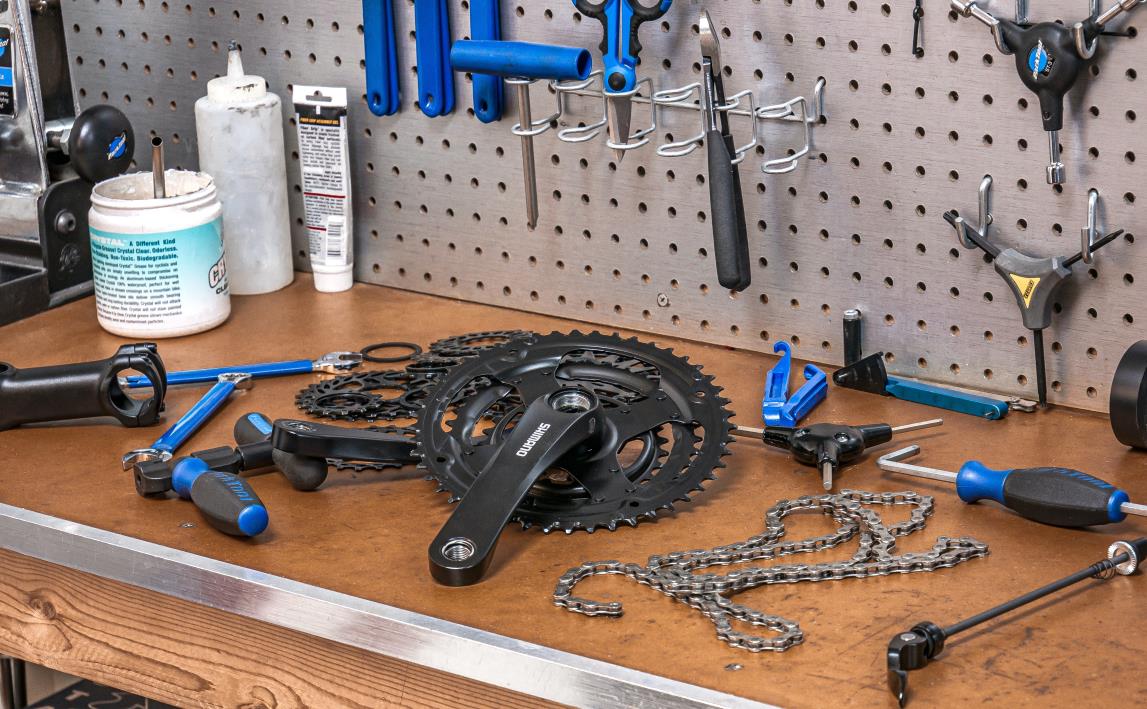
Photo by Tom Conway on Unsplash
Get your FREE 31 Structures Indoor Cycling Training Sessions and Training Plan
If you're looking to unravel the mystery of bicycle gear ratios, you're in the right place. Gearing up (pun intended) for your rides can make all the difference in your performance, whether you're tackling steep hills or gliding along flat terrain. In this guide, we're going to jump into the world of gear ratios, break down the basics, explore common setups, and help you understand how to make the most of your gears to conquer any road.
Demystifying Gear Ratios: The Basics
Think of gear ratios as the secret sauce that empowers your bike to adapt to different riding conditions. In simple terms, they determine how many times the rear wheel spins for each rotation of the pedals. A higher gear ratio means more distance covered per pedal stroke, perfect for those powerful sprints or cruising on level roads.
Conversely, a lower gear ratio offers more pedal revolutions for each wheel turn, ideal for conquering challenging inclines.
Choosing a High or Low Gear
When on a ride you may have heard a fellow rider say “you should choose a higher gear for this section” or “change to a low gear now” but what does it mean?
Choosing a low gear refers to selecting a combination of chainring and cassette cog that results in easier pedalling, requiring less effort to turn the pedals for a given distance. In other words, it's like downshifting to an "easier" gear that provides a mechanical advantage when you need to pedal against resistance, such as when climbing a hill or starting from a standstill.
Low gears have smaller chainrings at the front and larger cassette cogs at the rear. This combination allows you to maintain a comfortable and efficient pedalling cadence while tackling challenging terrain or situations that demand less force and more revolutions of the pedals.
When you're in a low gear, your bike will cover less ground with each pedal stroke compared to a high gear, but you'll be able to pedal more easily. This is especially useful when you encounter steep inclines, technical sections, or situations where you want to conserve energy.
In summary, choosing a low gear means opting for a combination that makes pedalling easier, allowing you to navigate tough terrain or maintain a steady cadence with less physical strain. It's all about finding the right balance between your effort and the resistance you're encountering.
Choosing a high gear means selecting a combination of chainring and cassette cog that requires more effort to pedal but allows you to achieve higher speeds and cover more ground with each pedal stroke. High gears are typically used on flat terrain or descents when you want to maximize your momentum and speed.
High gears have larger chainrings at the front and smaller cassette cogs at the rear. This combination results in a higher gear ratio, requiring more effort to pedal but allowing for greater speed and momentum on flat terrain or descents.
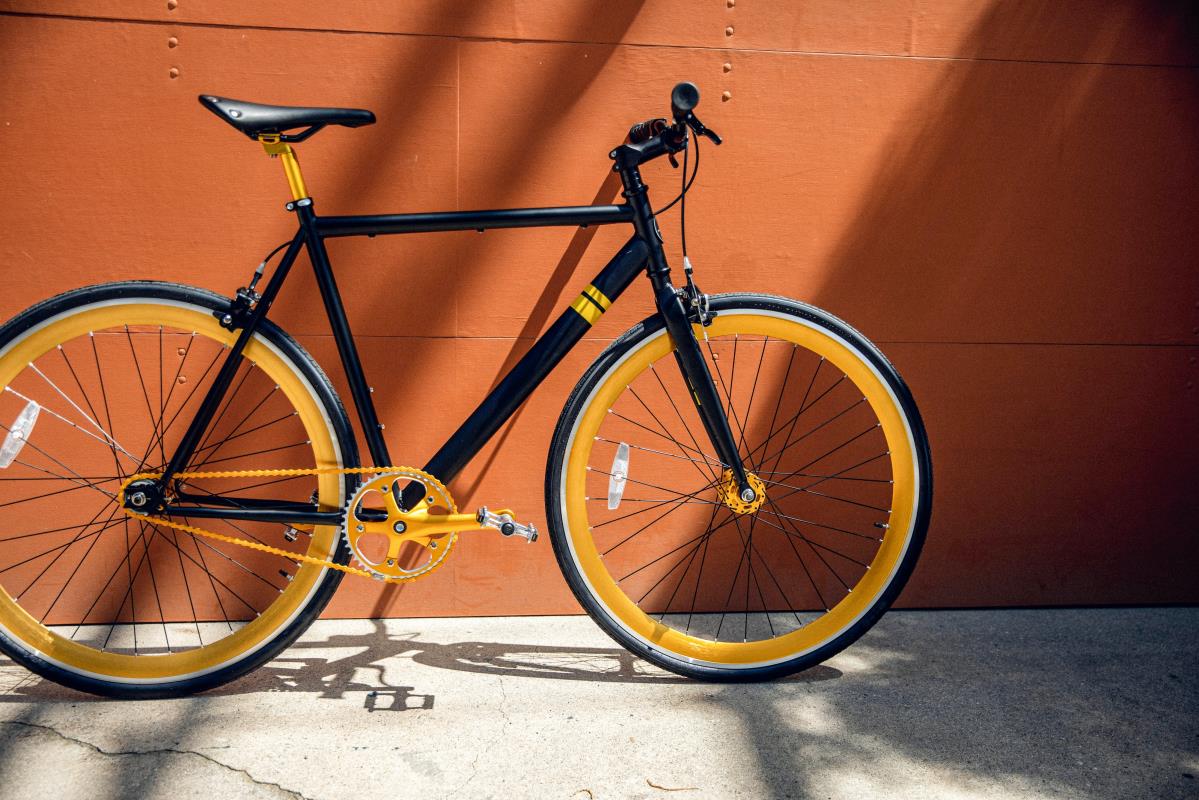
Photo by Tom Conway on Unsplash
Get your FREE 31 Structures Indoor Cycling Training Sessions and Training Plan
How many Gear Teeth do you need?
The number of teeth on your bike's chainrings and cassette cogs plays a significant role in determining how your bicycle responds to your pedalling effort. Let's break down how the number of teeth impacts your cycling experience:
Chainring Teeth
The chainrings are the gears attached to the front of your bike's crankset. They come in various sizes, commonly ranging from around 34 to 53 teeth. The number of teeth on the chainring directly affects how much effort is required to turn the pedals and the speed you can achieve. Here's how it works:
- Larger Chainring (More Teeth): A chainring with more teeth requires more effort to turn, but it translates your effort into higher speed. This is great for flat terrain and downhill sections, where you can build and maintain higher speeds with fewer pedal rotations.
- Smaller Chainring (Fewer Teeth): A chainring with fewer teeth requires less effort to turn, making it easier to pedal. This is beneficial for climbing hills and maintaining a comfortable pedalling cadence even when faced with steeper gradients.
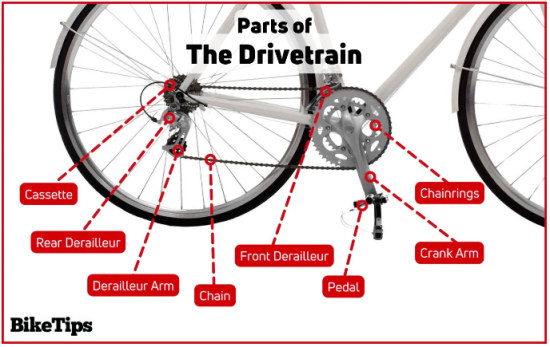
Parts of the bike drivetrain Source: biketips.com
Cassette Cog Teeth
The cassette is the cluster of gears at the rear wheel of your bike. It also comes in various configurations, typically ranging from 11 to 32 teeth or more. The combination of chainring and cassette cog sizes determines your overall gear ratio. Here's how the cassette cogs affect your cycling:
- Larger Cog (More Teeth)
A larger cog on the cassette makes it easier to pedal, ideal for climbing hills or tackling challenging terrain. It allows you to maintain a steady cadence without putting excessive strain on your muscles.
- Smaller Cog (Fewer Teeth)
A smaller cog on the cassette results in a higher gear, requiring more effort to pedal but delivering higher speeds. This is suitable for flat roads or downhill stretches where you want to maximize your momentum.
Finding the Right Balance
The art of cycling efficiently lies in finding the right balance between your chainring and cassette cog selections. A well-chosen combination ensures you can maintain a comfortable pedalling cadence (usually around 70-100 revolutions per minute) while adapting to the changing terrain. The goal is to avoid straining your muscles excessively or spinning your pedals too quickly without making progress.
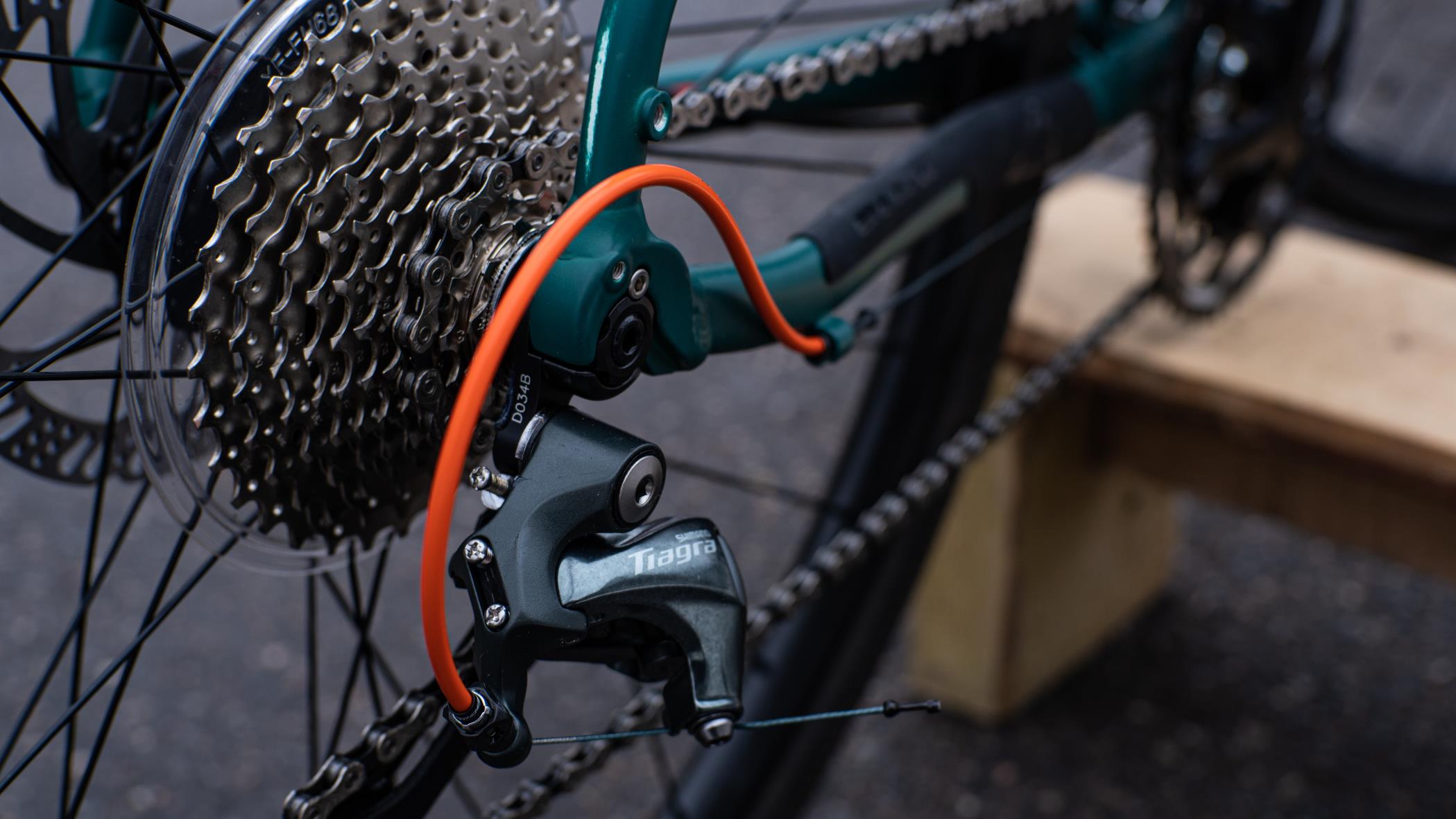
Bike rear cassette Photo by 맥심 on Unsplash
Get your FREE 31 Structures Indoor Cycling Training Sessions and Training Plan
Cadence Matters
Remember, maintaining an optimal cadence is essential for efficiency and reducing the risk of fatigue. Too low of a cadence can lead to muscle strain and exhaustion, while too high of a cadence might not provide enough power. Your ideal cadence might vary based on factors like your fitness level, the terrain, and your personal preference.
As a triathlete you should consider aiming for a cadence of around 90 RPM to match your typical run cadence of 180 SPM, so you feel more comfortable going from bike to run. But everyone is different to finding which cadence works for you during Brick sessions is essential.
Common Gear Setups and Ratios
Now, let's take a closer look at some typical gear setups you're likely to encounter:
Standard Double Chainring
This classic setup offers two chainrings at the front and a range of gears at the rear. It's a versatile choice, with larger chainrings (50-53 teeth) for flat-out speed and smaller ones (34-39 teeth) for climbing steeper gradients.
Double chainrings come in three typical setups:
- Standard: 53 tooth big chainring / 39 tooth small chainring
- Semi compact: 52/36
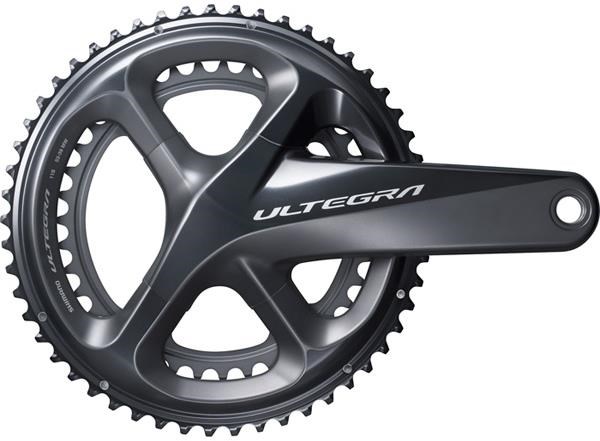
Shimano Ultegra Double Chainset
Compact Double Chainring
Designed with climbing in mind, this setup features smaller chainrings (usually 34-36 teeth) combined with a wider range of rear gears. It's perfect for hilly terrain and long-distance rides.
A typical set up would be for a Compact is 50/34. This is what most bikes will come with as it’s a “jack of all trades” chainring and good for most terrains.
The Pros and Cons of compact and standard double chainrings:
- Gear changes can feel chunky. It’s because you are moving the chain from a small gear to a large one, further than a triple requires.
- Doubles are less complicated. Given the fact that you’re only moving it one gear at a time instead of three, the derailleur doesn’t require such a large range of movement, like a triple.
- Doubles weigh less. Chainrings can weigh up to about 8 ounces, making the compact double set-up considerably lighter than a triple.
- Doubles are cheaper when compared to a similar make and model of a triple.
- Doubles can make you stronger simply because you’re using fewer gears to accomplish the same thing and have to push harder at a lower cadence.
- Compact chainsets have become massively popular because they allow you to keep moving up steep hills, albeit sometimes quite slowly, and many people prefer to turn smaller gears at a higher cadence (the number of pedal revolutions per minute) because it puts less stress on the knees.
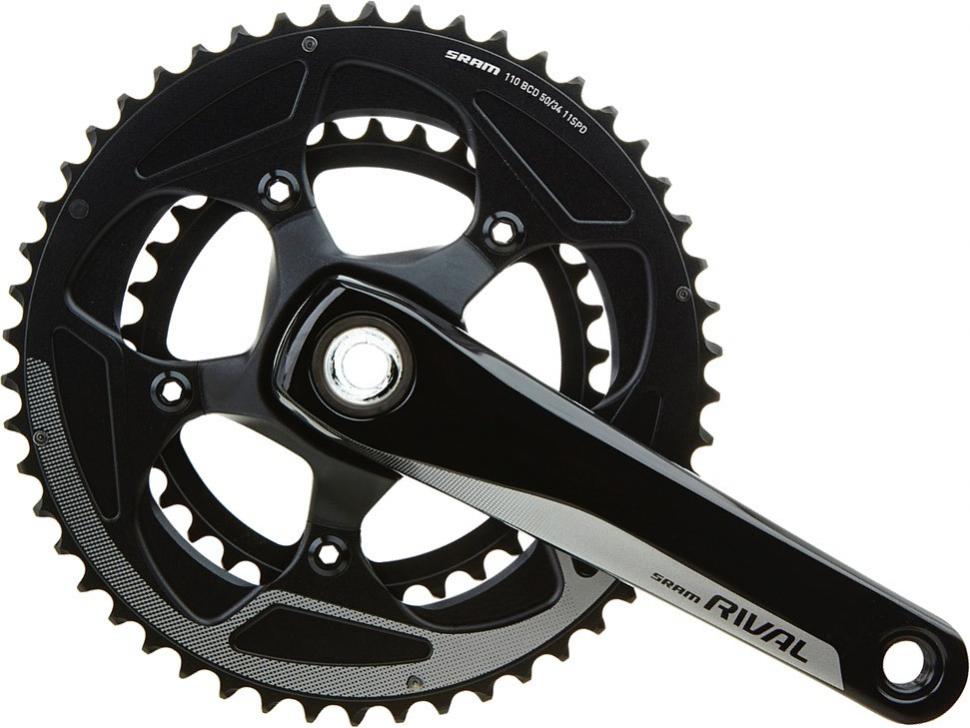
SRAM Rival Compact Chainset
Triple Chainring
Although less common nowadays, a triple chainring setup provides three front chainrings, offering an extensive range of gears. It's excellent for tackling steep ascents, but modern rear cassettes have made this setup less essential. This configuration is now mostly seen on Mountain Bikes.
A standard triple had a 52-42-32 gear combo but has since moved toward a 53-39-30 which is a standard crank with a “granny-gear”. But stating that any tooth count is “standard,” gets you into trouble, because manufactures use any and all combination of gears they choose to. Some manufacturers offer over 100 different combinations of crankset-cassette gearing.
The Pro’s and Cons of Triple Chainrings:
- You need to shift more often using a triple. With a wider range of gears, there’s almost always one that’s perfect for your riding conditions. The gears are closer together, so you’re more likely to find something that works well at the right time.
- More adaptable. If you’re not a particularly strong cyclist or you’re carrying a lot of weight, a triple offers you more choices of gearing and lower gears as well to more easily get up the steep stuff.
- Triples climb like crazy. It’s already been established that triples climb better than doubles. If you live in an area of rollers, hills and valleys, and do most of your riding there, the triple might be the gear of choice for you.
- Won’t Spin Out. Triples, with the bigger, higher tooth count, typically top out higher than compact doubles. Spinning out is a term used by professionals to describe the point where you can’t pedal any faster.
- Better chain line. Triples have a better chain line than doubles. Cross-chaining is a condition where the chain is operating at an angle. It’s hard on the chain and gears. Triples help to align the chain straighter and are less likely to cross chain.
- Easier on the knees. Since you have more gear options, you’re less likely to mash the pedals using a triple. Mashing continuously can hurt your knees. Triples are more friendly to your knees.
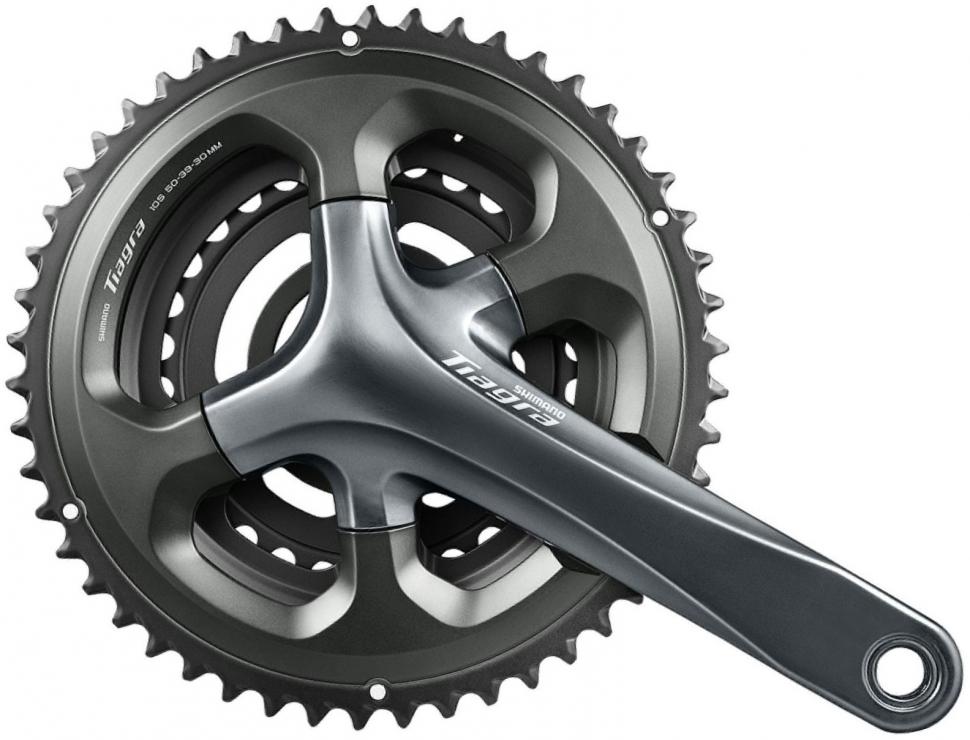
Shimano Tiagra Triple Chainset
Single Chainring (1x or “one-by”)
Embraced by mountain bikers and some road cyclists, a single chainring paired with a wide-range cassette simplifies shifting and reduces weight. The rear cassette's range becomes crucial in determining the versatility of this setup.
Because 1x drivetrains only have one chainring, they eliminate the need for a front derailleur. The front derailleur shifter is also eliminated, as is the gear cable that would typically run between the shifter and front derailleur.
This configuration is popular on Gravel bikes. If your riding sees you heading out on more technical gravel terrain and you’d prefer the benefits of the simplicity and improved chain retention, then a 1x drivetrain may be the choice for you.
Some pro cyclists use this configuration on their road bikes on flat stages and cobbles as the chain jumps less. This can also be good for Time Trails and some flat triathlon courses.
Pros and Cons of a 1x:
- Lighter- Because 1x drivetrains don't have a front derailleur, front shifter, and one less chainring, they weigh 250-450 grams less than 1x drivetrains.
- Easier to use - There is only one shifter to work.
- Longer lasting - 11 and 12 speed chains are more durable than 8, 9, and 10 speed chains.
- Less efficient - 1x drivetrains run the chain at a greater angle, higher speed, and at higher tension. This causes more friction. 1x loses about 3 watts more power to friction than 2x.
- Less gear range - Current 1x drivetrains max out at 520% gear range.
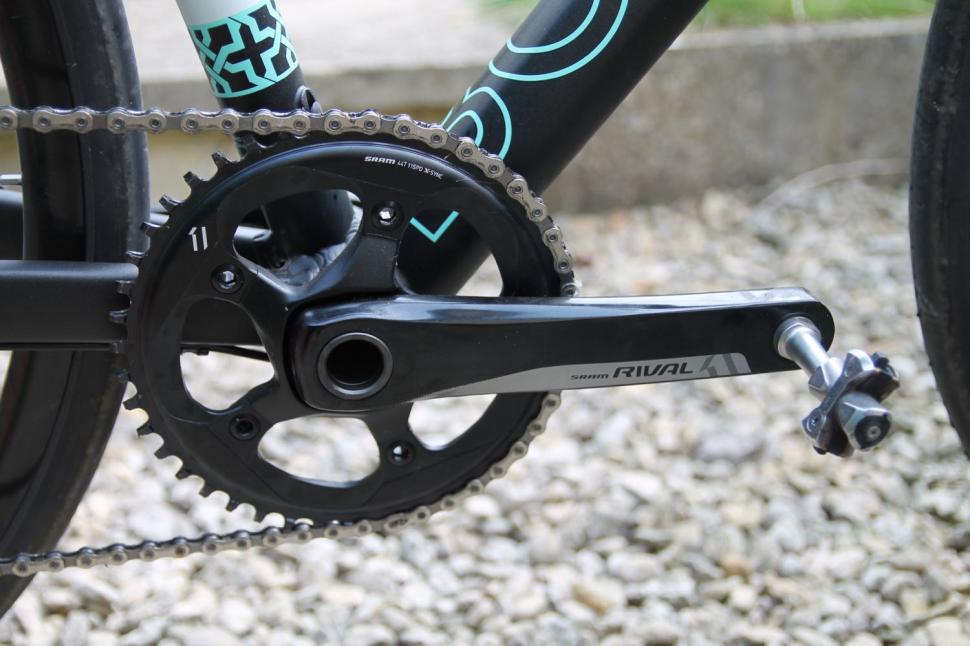
SRAM Single 1x Chainset
Get your FREE 31 Structures Indoor Cycling Training Sessions and Training Plan
Impact on Cycling: Conquering Hills and Slicing Through Flats
Hill-Crushing Ratios
When you're tackling hills, lower gear ratios are your trusty sidekicks. They let you maintain a comfortable cadence (that's how fast you're pedalling) while ascending steep inclines. Aim for a gear that allows you to pedal smoothly without straining your muscles. A compact double or even a triple chainring setup can be your hill-conquering allies, ensuring you don't burn out before reaching the summit.
Flat Terrain Mastery
On flat surfaces or descents, higher gear ratios become your best buddies. They enable you to generate more speed with fewer pedal rotations. This is where larger chainrings come into play, letting you maximize your power output and cover more ground with each pedal stroke.
You could also consider a 1x single chainring.
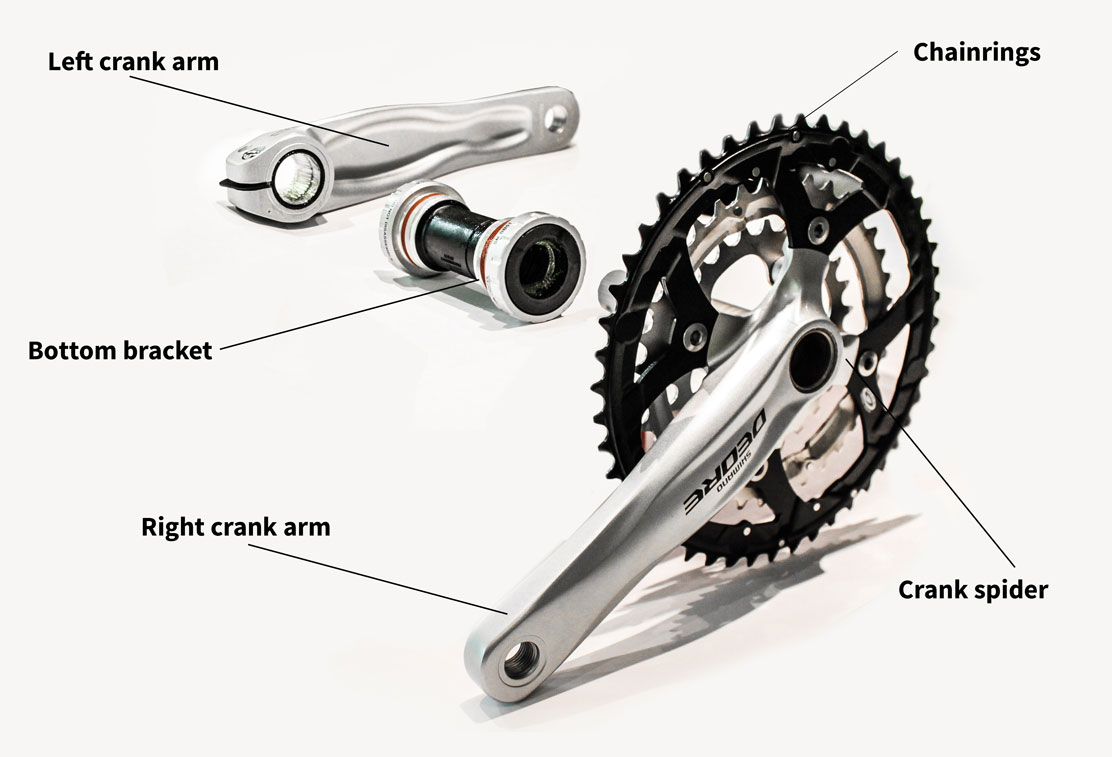
An explode view of Shimano Deore Chainset
Finding Your Perfect Gear Ratio
The golden rule here is experimentation. Every rider's fitness level, riding style, and terrain preferences vary. So, hop on your bike, hit the road, and play around with your gears. Test different combinations on various terrains to get a feel for what suits you best. As you ride more, you'll start developing an intuitive sense of which gear ratios work for different situations.
Gear Ratios
If your biggest chainring has 52 teeth and you’re turning a 26-tooth cog at the rear, the ratio is 2:1 – meaning a complete pedal revolution turns the rear wheel twice.
The greater the difference between the size of front and rear gears, the harder it will be to push.
Linked to choosing gear ratios is the concept of cadence i.e., how many revolutions per minute you turn the pedals.
Although varying between riders, in the region of 90-110rpm is considered ‘standard’. If you wanted to trundle along the flat at 24kph, you might select a 36×17 combination, allowing you to spin at a reasonable 90rpm.
In theory you might instead select a 52×12 ratio, which only requires a cadence of 45rpm.
Although you may think turning the pedals fewer times a minute for the same speed would be beneficial, this would be a difficult gear to ride at relatively low speed.
Example: A 39T chainring is paired with a 12T cog, giving us a ratio of 39:12 or 3.25. So, one complete rotation of the crank will make the rear wheel rotate 3.25 times.
Let’s look at the Trek Madone SL6:
It is an 11 speed Shimano Ultegra R8000 50/34T compact set up. The chainring (front) on my bike is 50/34T. That means the outer ring has 50 teeth and the inner ring has 34 teeth.
The rear cassette is 11 speed 11-32. This means there are 11 cogs ranging from 11 teeth up to 32 teeth (the exact cogs are 11/12/13/14/16/18/20/22/25/28/32).

Table showing the rear cassette cogs 11 to 32 and the gear ratios and wheel revolutions
The combination of your selected chainring and cog determine the gear ratio. The gear ratio, combined with the circumference of your wheel and tyre determines how far you will travel with each revolution of the cranks.
The Hardest Gear
Let’s say I am in the hardest gear on each which means I would be riding on the 50-tooth ring on the front, and the 11-tooth ring on the back. To get our gear ratio we divide the number of teeth on the front by the number on the back:
50 ÷ 11 = 4.55
This is expressed as 4.55 : 1 meaning that for every 1 turn I make of the pedals at the front, I will turn the back wheel 4.55 times. This is the gear I would use on the flat. It is going to take quite a lot of effort to get it moving, but when I do, I will move quickly.
The Easiest Gear
This would be the opposite end, the small ring on the front and the biggest on the back. The reason for this is that they are the closest together, meaning you get a really low ratio. On the bike I ride this is 34 teeth at the front and 32 at the back – so really close.
34 ÷ 32 = 1.06
1.06 : 1 means I am only just moving the back wheel through more than one revolution for every turn of the crankset. This would be the gear I am using on the very toughest of climbs allowing mean to spin the wheels quickly to get my cadence high.
For help calculating the gear range of different cassette and chainring combinations, you can use this tool from Sheldon Brown.
Conclusion and Final Thoughts about Gears
Understanding bicycle gear ratios might seem like a complex puzzle, but with a little patience and practice, you'll master the art of gear shifting. Remember, your gears are there to empower your ride, making it more enjoyable and efficient.
The number of teeth on your chainrings and cassette cogs directly influences the effort required to pedal and the speed you can achieve. Understanding this interplay allows you to select the right gear ratios for different situations, whether you're conquering hills or cruising on flat roads.
Most road bikes come with a compact double chainring which is a good all-rounder and good place to start.
Experiment with different combinations, pay attention to your cadence, and soon you'll be a gear-shifting pro, optimizing your cycling experience for every adventure on the road.
So, fellow cyclists and triathletes, gear up, pedal on, and enjoy the incredible journey that is cycling—where every gear ratio brings you one step closer to becoming a true road warrior and tenacious triathlete.
Ride safe, ride strong, and happy cycling!
Karen Parnell is a Level 3 British Triathlon and IRONMAN Certified Coach, 8020 Endurance Certified Coach, WOWSA Level 3 open water swimming coach and NASM Personal Trainer and Sports Technology Writer.
Karen has recently completed a postgraduate MSc in Sports Performance Coaching at the University of Stirling.
Need a training plan? I have plans on TrainingPeaks and FinalSurge:
I also coach a very small number of athletes one to one for all triathlon and multi-sport distances, open water swimming events and running races, email me for details and availability. Karen.parnell@chilitri.com
Get your FREE Guide to Running Speed and Technique
Get your FREE Swim Workouts for Triathletes E-book
Get your FREE Open Water Swimming Sessions E-Book
Get your FREE 31 Structures Indoor Cycling Training Sessions and Training Plan
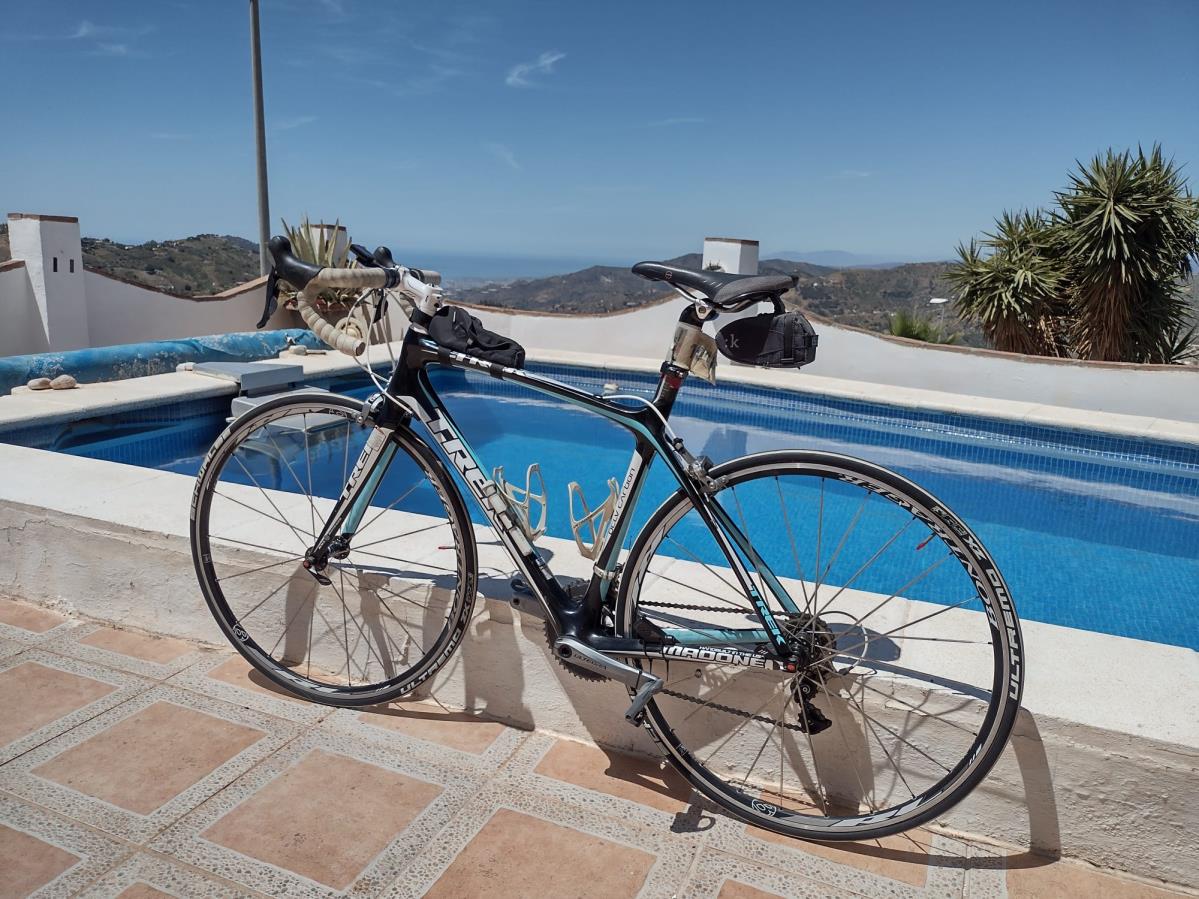
Karen's Trek Madone with a compact chainset. Photo taken at ChiliTri, Spain
FAQ: Cycling Gear Ratios
What are chainrings and cassettes?
Chainrings are the gears attached to the front of your bike's crankset, connected to the pedals. Cassettes are the cluster of gears located at the rear wheel. They work together to determine the available gear ratios on your bike, allowing you to adapt to different riding conditions.
How do chainring sizes impact cycling?
Chainring sizes, measured by the number of teeth, affect the effort required to pedal and the speed you can achieve. Larger chainrings (more teeth) require more effort but provide higher speeds, ideal for flat terrain. Smaller chainrings (fewer teeth) make pedalling easier, suitable for climbing hills.
What about cassette cog sizes?
Cassette cog sizes, also measured by the number of teeth, complement chainring sizes. Larger cogs make pedalling easier, perfect for hills, while smaller cogs offer higher speeds on flat terrain. Combining different chainring and cassette cog sizes creates various gear ratios for different scenarios.
What are gear ratios?
Gear ratios represent the relationship between the number of teeth on the chainrings and cassette cogs. They determine how much distance the bike covers per pedal revolution. Lower gear ratios are optimal for climbing hills, while higher gear ratios are suitable for flat roads and descents.
How do I choose the right gear ratio for hills?
For tackling hills, opt for lower gear ratios by using smaller chainrings and larger cassette cogs. This allows you to maintain a comfortable cadence while conquering inclines without overexerting your muscles.
Which gear ratios are best for flat terrain?
On flat roads or descents, higher gear ratios are effective. Use larger chainrings and smaller cassette cogs to maximize your speed and cover more ground with each pedal stroke.
What is cycling cadence?
Cycling cadence refers to the number of pedal revolutions per minute (RPM). Maintaining an optimal cadence, typically between 70 and 100 RPM, enhances efficiency and reduces fatigue. It's the balance between the effort you put into each pedal stroke and the speed you're aiming for.
How does cadence impact cycling?
Cadence plays a crucial role in efficiency and endurance. Too low of a cadence can strain muscles and lead to exhaustion, while too high of a cadence might sacrifice power. Finding the right cadence for the terrain and your fitness level helps you ride comfortably and efficiently.
How do I find the right gear ratio and cadence?
Experimentation is key. Test different gear ratios and cadences on various terrains to determine what feels comfortable and efficient for you. Over time, you'll develop an intuitive sense of which combinations work best for different riding conditions.
Can I change gear ratios while riding?
Absolutely. Most bikes are equipped with gear shifters that allow you to change between different chainrings and cassette cogs on the go. Shifting to lower gears when climbing and higher gears when descending or riding on flat terrain optimizes your performance.
Remember, mastering chainrings, cassettes, gear ratios, and cycling cadence takes practice. Embrace the learning process, pay attention to how your body responds, and soon you'll be fine-tuning your gear selection and pedalling rhythm to conquer any cycling adventure with confidence.
References
1x drivetrains explained: an in-depth guide to running a single-ring drivetrain - BikeRadar
Bike Gears Explained: A Beginners Guide To Bike Gears (yellowjersey.co.uk)
1X Vs 2X Drivetrain: Pros and Cons - Where The Road Forks
What are Bike Gear Ratios? - I Love Bicycling
Cyclist guide to the right road bike gear ratios for climbing | Cyclist
